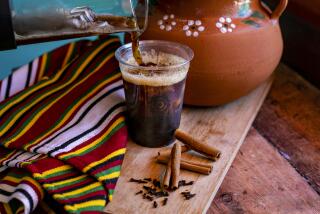Cahokia people had caffeine drink made from holly 900 years ago
- Share via
Residues on pottery cups indicate that residents of the pre-Columbian site of Cahokia, near what is now St. Louis, brewed a strong tea from the leaves and branches of holly, researchers reported Monday.
The discovery represents the oldest use of the so-called Black Drink in North America and, because the shrub itself is normally found only along the East and Gulf coasts, suggests the existence of well-established trade routes linking wide areas of the continent.
Cahokia was a massive settlement near the confluence of the Missouri and Mississippi Rivers. It grew from clusters of farms that spread across the fertile Mississippi Valley beginning about AD 800 and blossomed around AD 1100.
At its height, the city had many massive mounds on both sides of the Mississippi River, and a population that estimates place between 15,000 and 50,000. For reasons that are still unknown, it was abandoned by the 1300s.
When the Spanish arrived on this continent, they documented that natives in the southern areas were drinking a beverage the Spanish called Black Drink. A dark tea made from the dried, roasted leaves of the Yaupon holly (Ilex vomitoria), the Black Drink had as much as six times the caffeine content of modern coffee.
The native Americans used it for a variety of ceremonial purposes, but one important one was purification before important events or battles. The drink induced sweating and, when consumed rapidly in large quantities, produced vomiting, an important part of the purification ritual.
A team led by anthropologist Patricia L. Crown of the University of New Mexico studied eight beakers from ritual sites in and around Cahokia, dating from AD 1050 to AD 1250. The beakers, which appear to be unique to Cahokia, are single-serving containers with a handle on one side and a small lip on the other. Many are carved with symbols representing water and the underworld.
The team reported in the Proceedings of the National Academy of Sciences that all eight contained traces of theobromine, caffeine and ursolic acid in ratios characteristic of the Black Drink. The discovery has five major implications, the team reported:
--It pushes back the date for the earliest recorded use of the Black Drink in North America by 500 years.
--It demonstrates the presence of the holly far north of its natural distribution, indicating that it was deliberately transported.
--It suggests that the beakers may have been manufactured specifically to play a role in the Black Drink ceremonies.
--It reinforces other evidence for the existence of a fertility/life-renewal cult at Cahokia that included the Black Drink ceremonies.
--It bolsters earlier suggestions that Cahokia played an important role in the subsequent religious development in the Southwest, where the Black Drink came to be widely used.
LATimesScience@gmail.com
twitter.com/@LATMaugh





